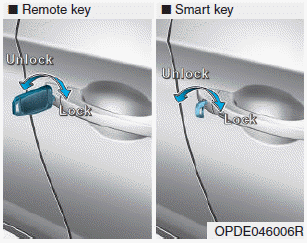Hyundai i-30: Emission Control System / Description and operation
Hyundai i30 (PD) 2018-2025 Service Manual / Emission Control System / Description and operation
| Description |
Emissions control system consists of the three major systems.
| • |
Crankcase emission control system prevents blow-by gas from going into
the atmosphere. This system burns these gases after moving them to the
intake manifold (Closed crankcase ventilation type).
|
| • |
Evaporative emission control system prevents evaporative gas going into
the atmosphere. This system burns the gases at appropriate engine operating
condition after gathering it in the canister.
|
| • |
Exhaust emission control system converts the three pollutants hydrocarbons
(HC), carbon monoxide (CO), and oxides of nitrogen (NOx) into harmless
substances by using the 3-way catalytic converter.
|
 Specifications
Specifications
Specifications
Purge Control Solenoid Valve (PCSV)
▷ Specification
Item
Specification
Coil resistance (Ω)
12...
Other information:
Hyundai i30 (PD) 2018-2025 Service Manual: Repair procedures
Removal [Manual Transaxle Type] 1. Turn ignition switch OFF and disconnect the negative (-) battery cable. 2. Remove the clutch pedal. (Refer to Clutch System - "Cluch Pedal") 3...
Hyundai i30 (PD) 2018-2025 Owner's Manual: Display
Display in cluster The cluster displays the speed limit information, overtaking restriction, detailed conditional speed limit and detailed overtaking restrictions. The cluster displays the speed limit information, overtaking restriction and conditional road sign...
Categories
- Manuals Home
- 3rd Generation i30 Owners Manual
- 3rd Generation i30 Service Manual
- Brake/clutch fluid
- Drive mode integrated control system
- Jump starting procedure
- New on site
- Most important about car
Door locks
Operating door locks from outside the vehicle
Mechanical key

Turn the key toward the rear of the vehicle to unlock and toward the front of the vehicle to lock.
If you lock/unlock the driver's door with a key, a driver’s door will lock/unlock automatically.
Copyright © 2025 www.hi30.net

